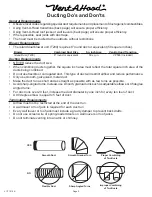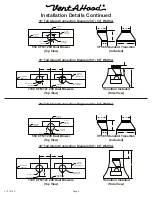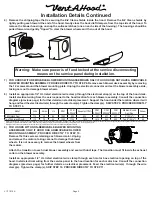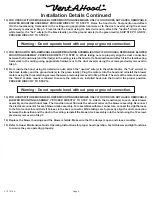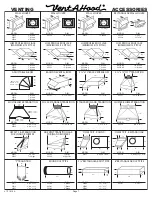
Page 6
L111 1015A
Installation Details Continued
Warning: Do not operate hood without proper ground connection.
13) FOR HOODS WITH REMOVABLE BLOWER MOUNTING ASSEMBLIES ONLY. IF HOOD DOES NOT HAVE A REMOVABLE
BLOWER MOUNTING ASSEMBLY, PROCEED DIRECTLY TO STEP 14. Attach the transition(s) to each deck blower
assembly and seal with duct tape. The transition must fit inside the exhaust collar on the blower assembly. Reconnect
the electrical connector for each blower deck assembly. For assemblies with two connectors, connect the right harness
to the front connector and the left harness to the back connector. While taking care to properly align the duct connection
between the transition and the duct in the ceiling, reinstall the blower deck assembly into the hood using the 12 screws
previously removed in Step 7.
14) Replace the blower housings and the blower shields. Make sure that the dampers open and close smoothly.
15) Refer to Owner Maintenance Guide Operating Instructions for proper hood operation. Test all blower and light functions
to ensure they are operating properly.
Warning: Do not operate hood without proper ground connection.
11) FOR HOODS WITH NON-REMOVABLE BLOWER MOUNTING ASSEMBLIES ONLY. IF HOOD HAS A REMOVABLE BLOWER
MOUNTING ASSEMBLY, PROCEED DIRECTLY TO STEP 12. While taking care to properly align the duct connection
between the transition(s) and the duct(s) in the ceiling, raise the hood to its final position and attach it to the load-bearing
framework in the ceiling using appropriate hardware or to the duct cover(s) using the screws previously removed in
Step 3.
12) From inside the hood, using UL listed wire nuts, attach the “neutral” wire(s) to the white lead(s), the “hot” wire(s) to
the black lead(s), and the ground wire(s) to the green lead(s). Plug the motors into the hood and reinstall the blower
motors using the three retaining screws that were previously removed in Step 9. Note: The side of the motor box where
the “black” motors mount is labeled to ensure the motors are installed back into the hood in the proper position.
PROCEED DIRECTLY TO STEP 14.
10) FOR HOODS WITH REMOVABLE BLOWER MOUNTING ASSEMBLIES ONLY. IF HOOD DOES NOT HAVE A REMOVABLE
BLOWER MOUNTING ASSEMBLY, PROCEED DIRECTLY TO STEP 11. Raise the hood to its final position and attach
it to the load-bearing framework in the ceiling using appropriate hardware or to the duct cover(s) using the screws
previously removed in Step 3. From inside the hood, using UL listed wire nuts, attach the “neutral” wire(s) to the
white lead(s), the “hot” wire(s) to the black lead(s), and the ground wire(s) to the green lead(s). SKIP STEP 11 AND 12.
PROCEED DIRECTLY TO STEP 13.


